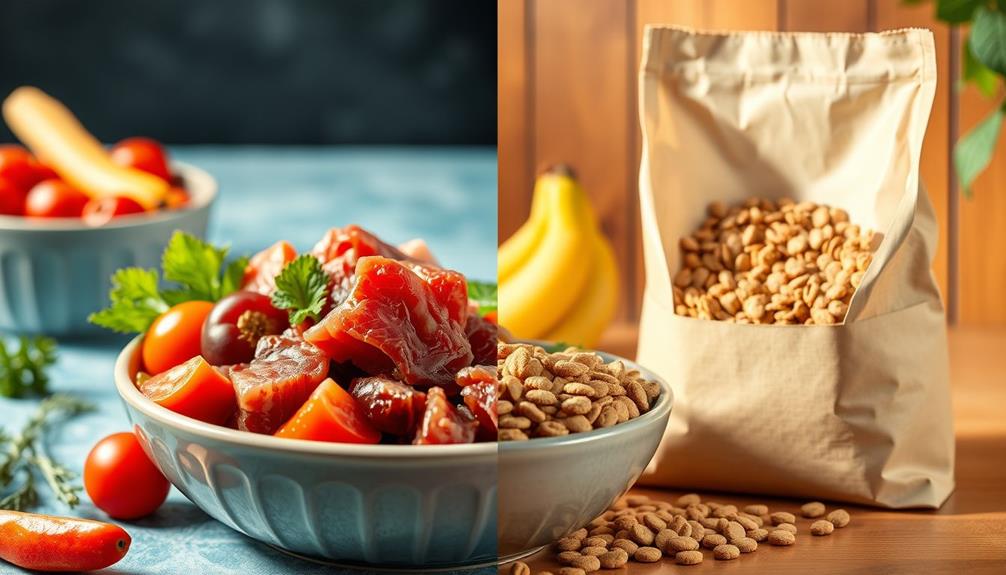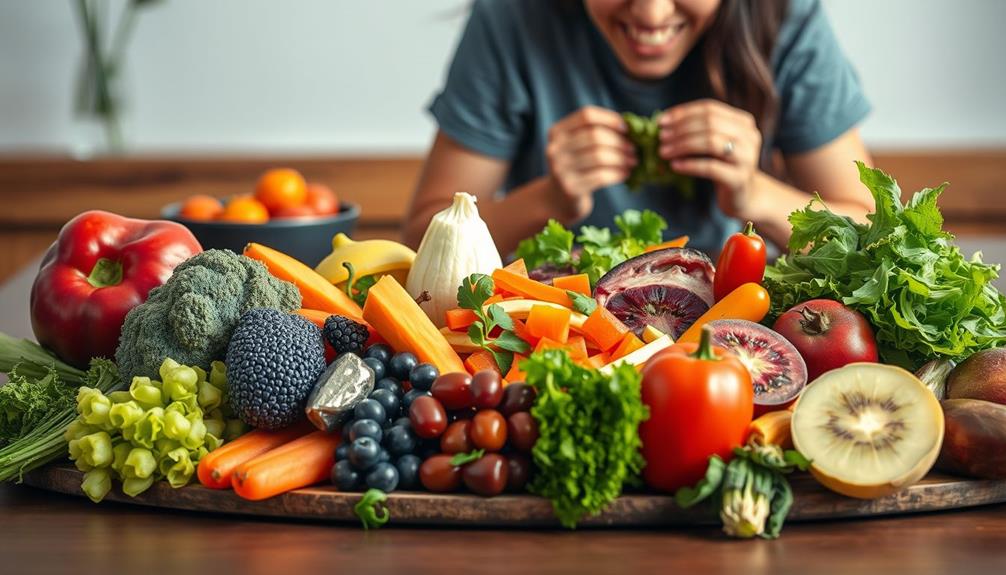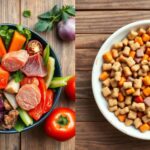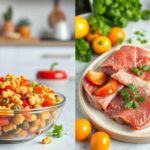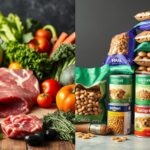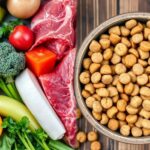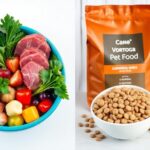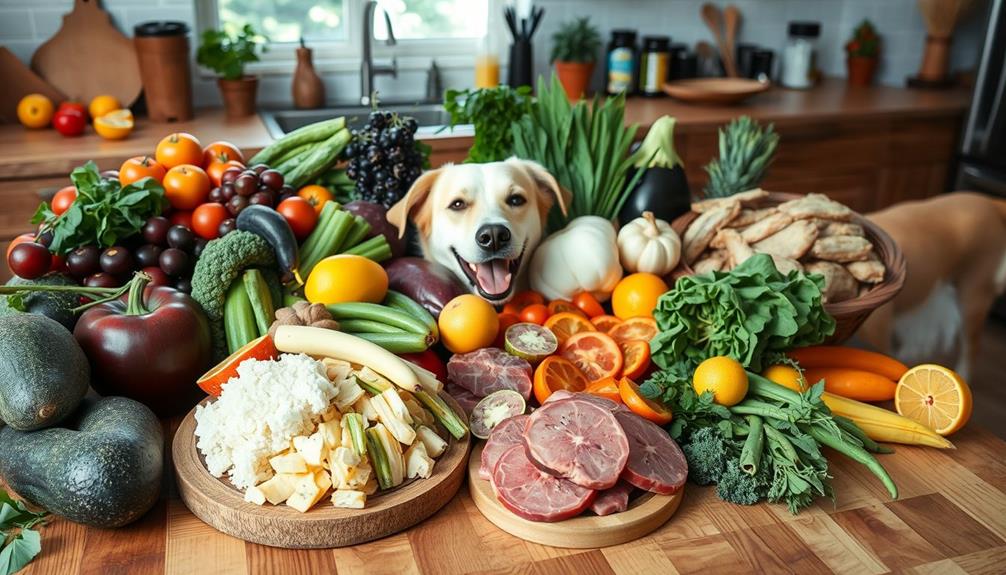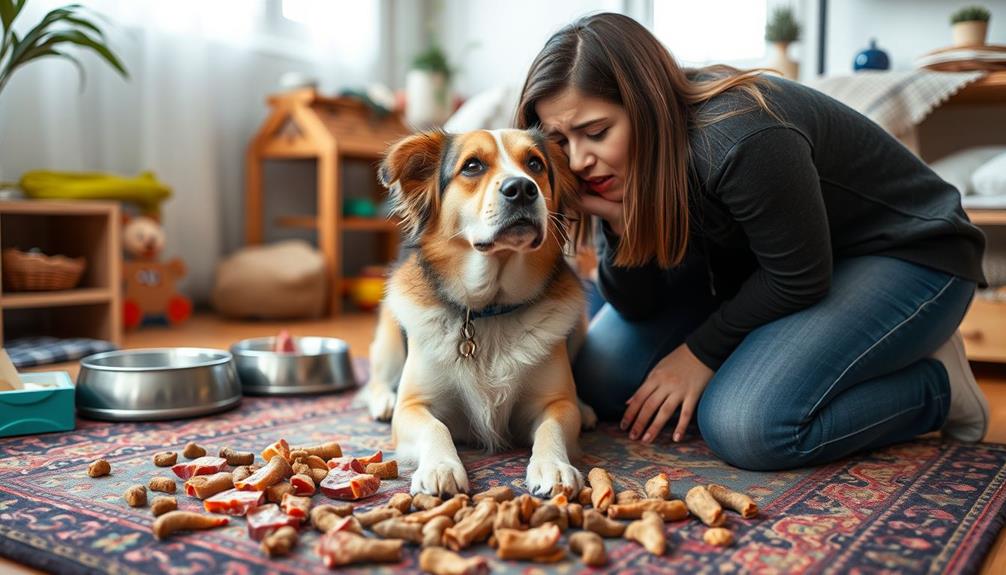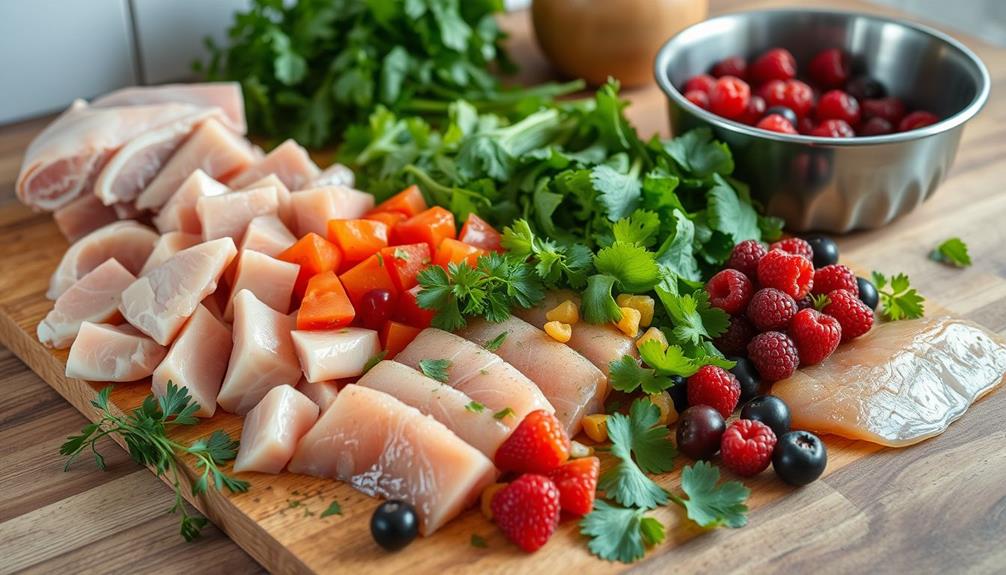When choosing between raw food and kibble for your dog, it's important to evaluate their nutritional content. Raw diets are rich in moisture and protein, with low carbohydrates, promoting better digestion and health. Kibble, on the other hand, often contains high carbs and low-quality fillers, potentially leading to obesity and other health issues. While some vets support raw feeding, others caution about risks, so consulting with a vet is wise. Ultimately, prioritizing your dog's nutritional needs can yield long-term health benefits. There's much more to explore about how each option impacts your furry friend's well-being.
Key Takeaways
- Raw food diets contain higher moisture levels and lower carbohydrates, promoting better hydration and digestion compared to kibble.
- Kibble often includes low-quality fillers and high carbohydrate content, which can lead to obesity and health issues.
- Raw diets preserve natural enzymes, aiding nutrient absorption and overall health, unlike kibble that requires synthetic additives.
- Transitioning to a raw diet should be gradual to avoid digestive upset, and monitoring health is essential during the process.
- While raw diets may have higher upfront costs, they can lead to long-term savings on veterinary expenses due to improved health.
Nutritional Value Comparison
When you compare the nutritional value of raw food for dogs and kibble, the differences become strikingly clear. A raw food diet typically contains 70-75% moisture, greatly enhancing hydration compared to kibble's moisture content of only 5-10%. This high moisture level not only helps keep your dog hydrated but also supports overall health.
Kibble often consists of 40-60% carbohydrates, which dogs don't biologically require, while raw diets focus on protein and fats, keeping carbs under 10%. Additionally, proper diet recommendations for pets emphasize the importance of quality ingredients in maintaining health.
The extreme heat processing of kibble destroys essential nutrients, leading to the need for synthetic additions. In contrast, raw diets preserve natural enzymes that aid digestion and nutrient absorption, enhancing their nutritional value.
You'll also notice that raw diets usually feature higher-quality, bioavailable ingredients, while some kibble brands contain low-quality fillers and artificial preservatives.
Health issues linked to kibble consumption, like obesity, are less common among dogs on a raw food diet. The benefits of raw feeding include improved health markers, such as shinier coats and increased energy levels.
Carbohydrates and Health Effects
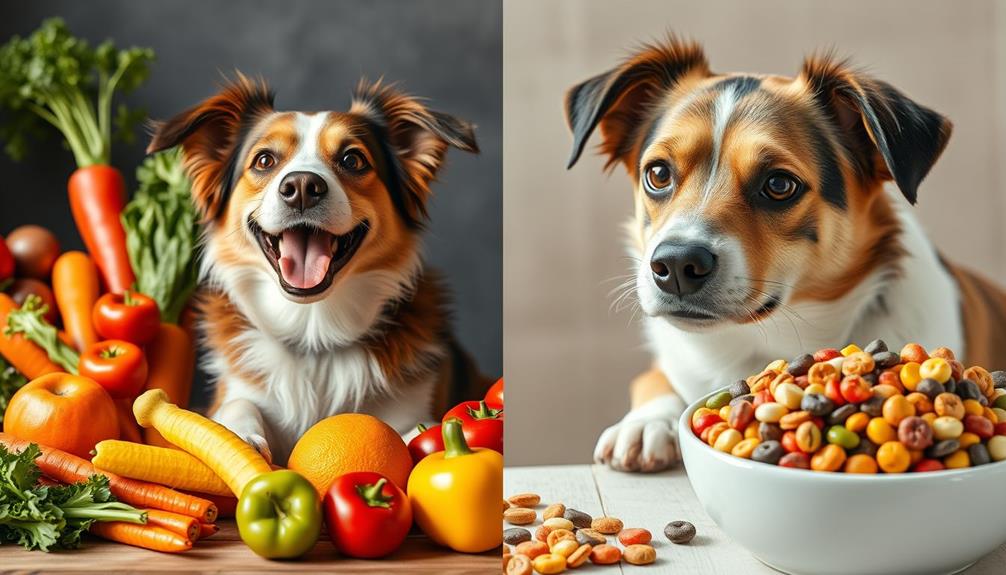
Carbohydrates can greatly impact your dog's health, and understanding their role in canine diets is vital. Dogs don't have a biological requirement for carbohydrates; their diets should mainly consist of proteins and fats for ideal health.
Kibble often contains 40-60% carbohydrates, which can contribute to obesity and other health issues like diabetes and pancreatitis. This excessive calorie intake can disrupt digestion and lead to energy fluctuations, leaving your dog feeling tired and lethargic. Additionally, nutritional benefits of a balanced diet can help prevent these issues.
On the other hand, raw diets typically have less than 10% carbohydrates, eliminating unnecessary fillers. This lower carbohydrate content promotes better digestion and enhances nutrient absorption, thanks to the natural enzymes found in raw foods.
By choosing a raw diet, you may support healthier digestion and help maintain stable energy levels in your dog.
Ultimately, evaluating the impact of carbohydrates in your dog's diet is important. A diet high in carbs can lead to obesity and other serious health conditions. By opting for raw diets, you can provide a more balanced nutritional profile that prioritizes your dog's health and well-being.
Transitioning to Raw Diets
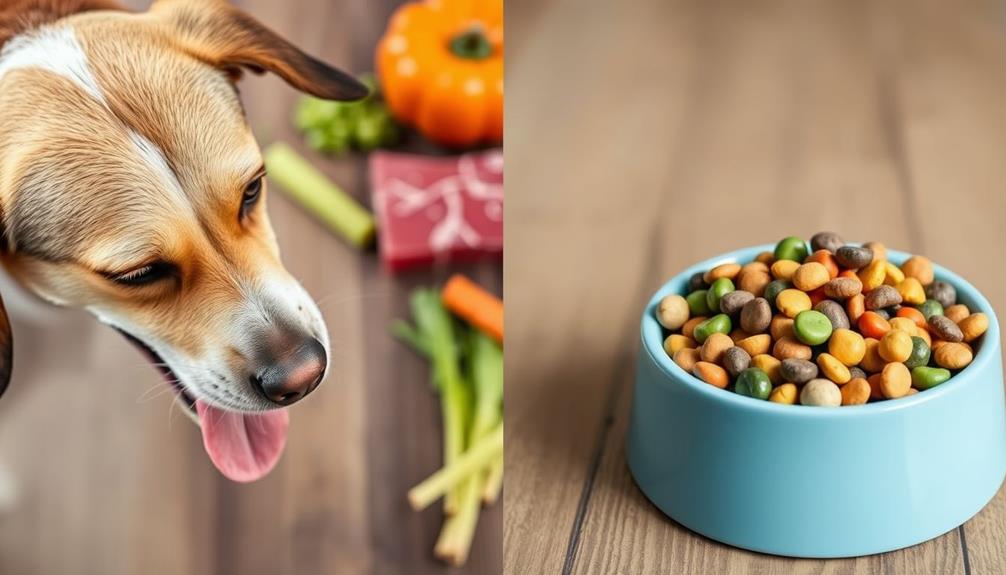
Shifting your dog from kibble to a raw diet can be a smooth process with the right approach. Start by gradually introducing raw food over a week or two. This method helps minimize the risk of digestive upset, allowing your dog to adjust comfortably.
You might want to use warmed bone broth to enhance the palatability of the raw food, especially if your dog isn't used to it yet. Additionally, it's important to keep an eye on your dog's hydration and overall health during this shift, as proper nutrition is essential for their well-being.
Consider consulting resources on cold medications overview to understand how dietary changes might interact with any medications your dog may be taking.
Following a structured switching guide can provide you with specific advice on portion sizes and meal types, ensuring your dog's nutritional needs are met during the shift. While mixing raw food with kibble is an option, it's not the most effective; some raw food is better than none.
Patience is key here. Some dogs may take longer to accept raw diets, so it's essential to be attentive. Keep monitoring your dog's response to the new diet, and be ready to make adjustments as needed.
With careful planning and a focus on their comfort, you can help your dog thrive on a raw diet.
Veterinary Opinions on Raw Food
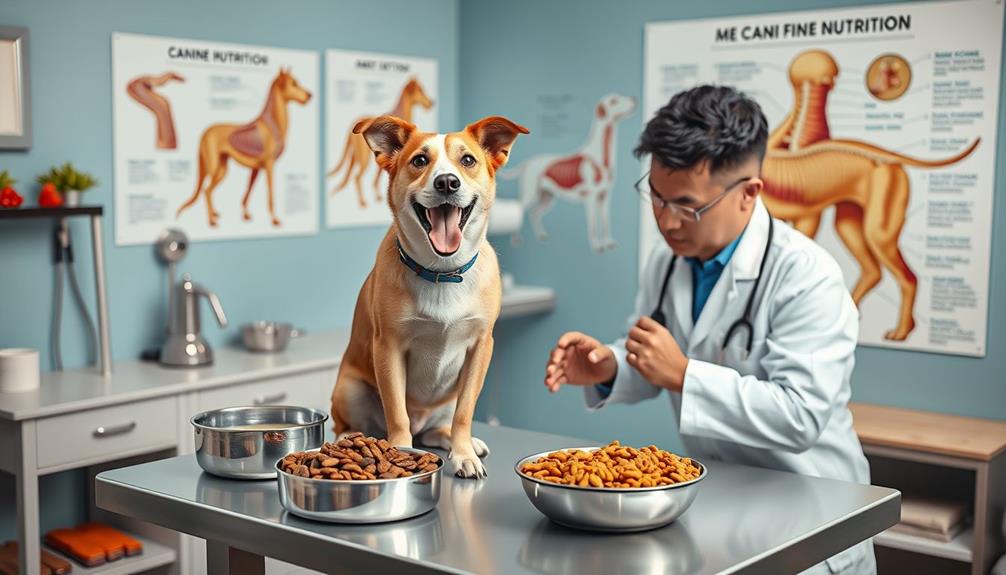
When it comes to raw food diets for dogs, you'll find a wide range of veterinary opinions. Some vets praise the benefits, while others highlight the risks, especially regarding safety handling practices.
It's important to reflect on your dog's specific health needs and consult a vet to discuss how a raw food diet may impact their overall health and well-being.
Additionally, understanding potential financial mistakes to avoid when investing in pet food options can help you make informed choices.
If you're contemplating this option, it's vital to consult a knowledgeable veterinarian to guarantee your dog's health and safety.
Varying Vet Perspectives
Veterinary opinions on raw food diets for dogs are a mixed bag, reflecting a spectrum of beliefs and practices within the profession. Some vets advocate for raw feeding, arguing it aligns with a dog's natural dietary needs and can lead to improved coat condition, dental health, and energy levels.
They often emphasize the importance of effective strategies for weight loss in maintaining a dog's overall health. However, they stress the importance of proper handling and preparation to mitigate risks associated with nutritional deficiencies and bacterial contamination.
On the flip side, many veterinarians express concerns about the potential health issues linked to raw diets, particularly for households with vulnerable individuals. Studies have shown that raw food can carry increased risks of bacterial contamination, prompting caution from certain professionals.
This is why consulting a vet knowledgeable about raw diets is essential before making any dietary changes; they can help you assess your dog's health status and nutritional requirements.
For dogs with specific health issues, many vets recommend balanced cooked diets instead, as these can provide a safer alternative while ensuring proper nutrition.
Ultimately, understanding varying veterinary opinions can help you make informed decisions about your dog's diet.
Safety Handling Practices
Understanding the varying opinions on raw food diets naturally leads to the significance of safety handling practices. If you're considering raw dog food, implementing strict safety measures is necessary to minimize health risks for both you and your pet.
| Safety Practice | Importance | Additional Tips |
|---|---|---|
| Proper Handling | Prevents cross-contamination | Always wash hands before and after |
| Food Preparation | Reduces risk of foodborne illnesses | Use separate utensils for raw food |
| Monitoring Reactions | Identifies adverse effects | Keep a log of your dog's responses |
When preparing raw food, store it at temperatures below 40°F to prevent bacterial growth. Hygiene practices are essential; make certain all surfaces and utensils are thoroughly cleaned. It's also significant to monitor your dog for any adverse reactions to the diet. If you notice anything unusual, consult a veterinarian knowledgeable about raw feeding for tailored dietary recommendations. Remember, awareness of potential pathogens in raw diets is imperative, especially in vulnerable households. Prioritize safety to enjoy the benefits of a raw diet without compromising health.
Safety and Handling of Raw Food
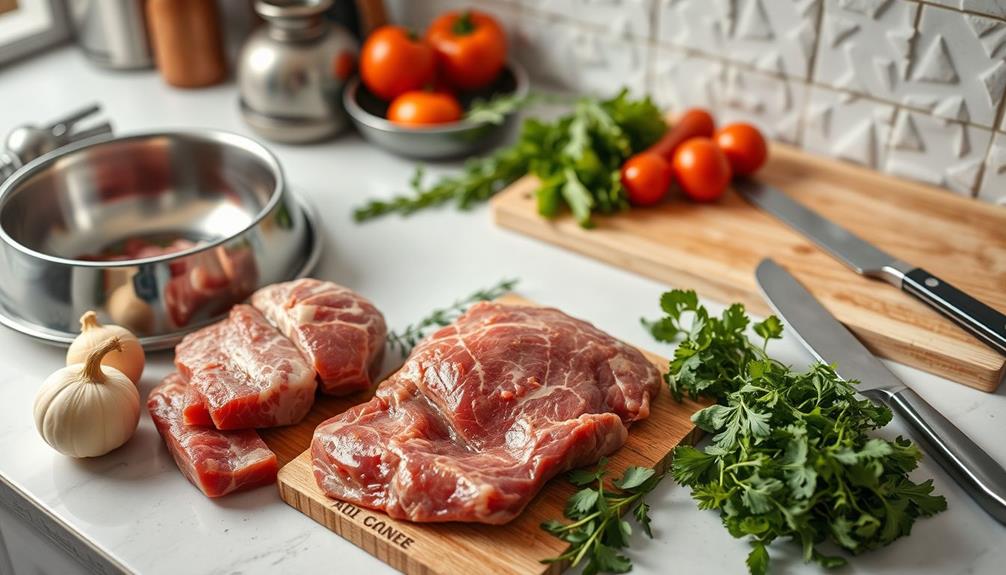
Ensuring the safety and proper handling of raw dog food is essential for keeping your pet healthy. To minimize the risk of bacterial contamination, always wash your hands, utensils, and surfaces thoroughly after preparing raw dog food.
Additionally, understanding the importance of financial considerations for elderly care can help you allocate funds for your pet's diet in the long run. Store raw meat at temperatures below 40°F (4°C) to prevent harmful pathogens from growing. Remember, thawed raw food shouldn't sit at room temperature for more than two hours.
Proper handling also involves using separate cutting boards for raw meat and other foods. This practice helps avoid cross-contamination that can endanger both you and your dog. After using any items that come into contact with raw food, wash them diligently.
As a pet owner, be vigilant for any adverse reactions when adapting your dog to a raw diet. It's a smart idea to consult a veterinarian knowledgeable in raw feeding for personalized advice.
Discard any leftover raw food that's been out for more than two hours, and always source your raw food from reputable suppliers that follow safety and quality standards. By being mindful of these safety and handling practices, you can confidently nourish your furry friend.
Cost Analysis of Diets
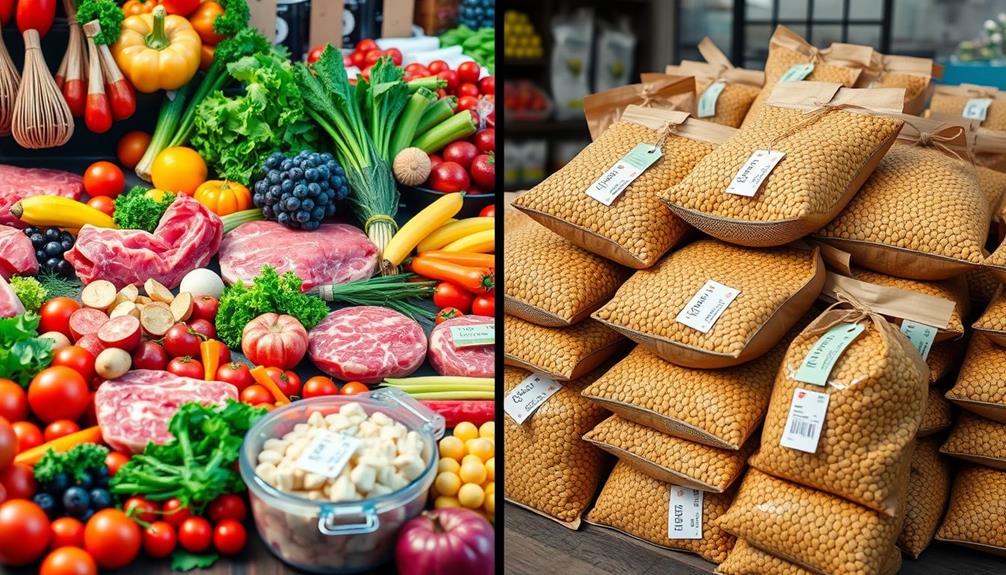
When comparing the costs of kibble and raw food diets, you'll notice daily feeding expenses can vary widely.
While kibble might seem cheaper upfront, long-term health costs from related health issues can add up.
Additionally, many pet owners find that investing in their dog's nutrition can lead to fewer vet visits, ultimately saving money in the long run.
By budgeting for fresh food options, you may find that investing in a raw diet pays off in both your dog's health and your wallet.
Best Websites to Earn Money Online
Daily Feeding Expenses
Daily feeding expenses can greatly impact your budget, especially when choosing between kibble and raw food diets for your dog. Typically, kibble costs range from $1 to $13 per day, depending on the brand and quality, while raw food diets usually fall between $3 to $10+ daily for a similar-sized dog.
While kibble is often cheaper upfront, kibble-fed dogs may face higher vet visits due to health issues linked to high carbohydrate content. Additionally, just as diversifying your retirement portfolio can protect against economic downturns, investing in your dog's diet can profoundly affect their long-term health and well-being, potentially reducing future medical costs related to poor nutrition long-term benefits of precious metals.
On the other hand, investing in raw diets might seem pricier at first, but this investment can lead to lower veterinary expenses over time. Healthier dogs tend to require less medical care, which can offset the initial costs of raw feeding.
Moreover, budgeting for ideal nutrition is vital. Fresh food services average around $8 per day for a medium-sized dog, making it essential to evaluate the nutritional costs involved.
Ultimately, your choice should balance immediate expenses with the potential long-term benefits for your dog's overall health. By weighing these factors, you can make a more informed decision that suits your financial situation and your dog's needs.
Long-term Health Costs
Over time, the health costs associated with your dog's diet can greatly impact your finances.
While a kibble diet may seem cheaper, ranging from $1 to $13 daily, it often leads to higher rates of health issues, such as obesity and dental problems, which can be mitigated by healthy dog snacks. These problems can drive up your long-term veterinary costs, offsetting any initial savings you might gain from choosing kibble.
On the other hand, investing in a balanced raw diet typically costs between $3 and $10+ daily, but the nutritional benefits can be significant.
Dogs on a raw diet often enjoy better digestion and reduced obesity, which may lead to fewer health problems down the road. This means you could spend less on veterinary visits over time, ultimately lowering your overall pet care expenses.
Choosing a raw diet can contribute to your dog's long-term health, promoting a longer, healthier life.
By prioritizing their nutrition now, you may reduce the frequency and cost of vet visits later.
Budgeting for Fresh Food
Investing in your dog's nutrition involves careful budgeting, particularly when considering fresh food options. Kibble prices generally range from $1 to $13 daily, while raw diets can cost between $3 to $10+ a day.
Although raw diets may appear pricier initially, the long-term savings on veterinary expenses due to improved health can balance out the costs. Additionally, just as with precious metals investments, it's vital to research and find reputable sources for your dog's food to guarantee quality and safety, similar to identifying a trusted provider for precious metal investments.
When budgeting for your dog's food, consider ingredient quality and potential health implications. Lower-quality kibble can lead to increased vet visits, making it a costly choice over time.
On the other hand, the nutritional benefits of raw diets, such as better digestion and overall health, can enhance your dog's quality of life and reduce future health issues.
Fresh food services that comply with AAFCO standards can help you manage your budget by offering customizable meal plans tailored to your dog's needs. These services guarantee balanced nutrition while allowing you to maintain control over your spending.
Ultimately, investing in a nutritious diet now can lead to a healthier dog and fewer veterinary expenses down the line, making raw diets a smart choice for your furry friend's future.
Mixing Kibble and Raw Food
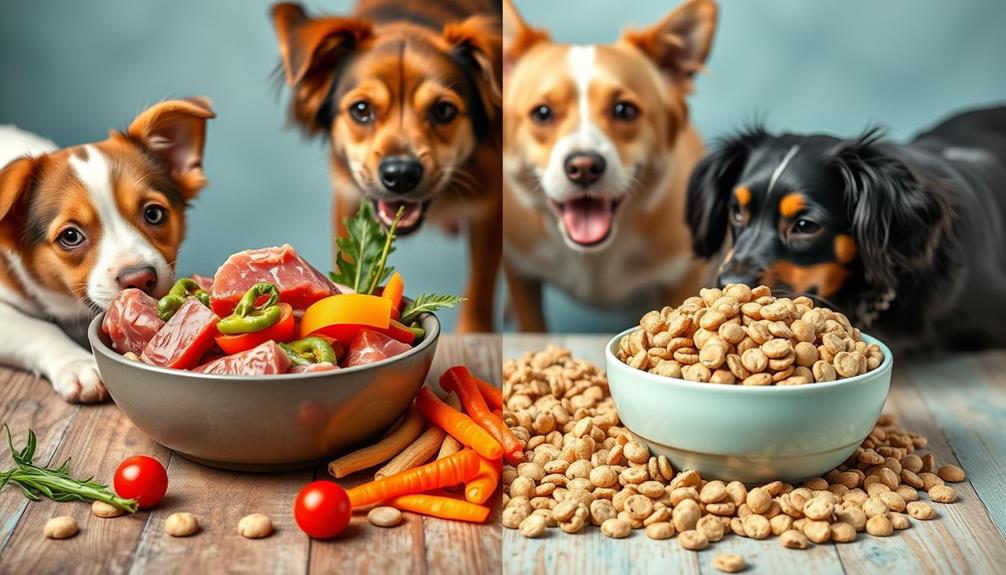
Mixing kibble and raw food can be a beneficial way to enhance your dog's diet, providing a balanced blend of essential nutrients.
This combination can improve the nutritional profile of your dog's meals by adding higher protein and moisture content that kibble may lack. However, it's vital to approach this shift carefully to avoid digestive upset.
Here are some important considerations when mixing kibble and raw food:
- Choose high-quality kibble: Verify the kibble you select is free from low-grade fillers and excess carbohydrates, which can detract from your dog's health.
- Gradual shift: Introduce raw food slowly to help your dog's system adjust and minimize the risk of digestive upset.
- Monitor for adverse reactions: Keep an eye on your dog for any sensitivities to raw ingredients or specific kibble formulations.
- Boost palatability and variety: Using raw food as a mix-in can make kibble more appealing, especially for picky eaters, while also adding variety in diet.
Characteristics of Kibble
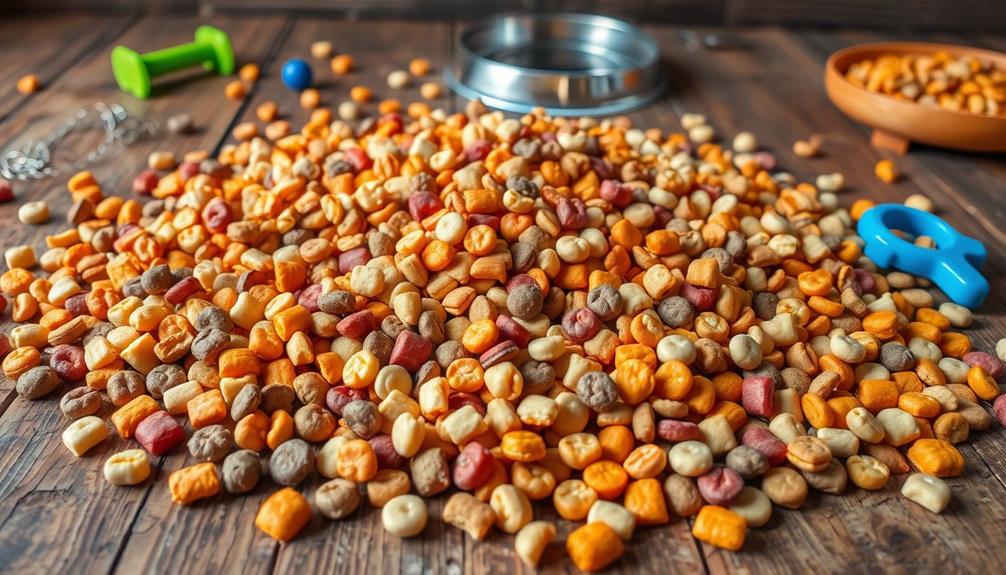
When you look at kibble, you're dealing with a dry dog food made through an extrusion process that can vary widely in nutritional composition.
The ingredient quality can also differ markedly from brand to brand, with some using questionable fillers.
Understanding these factors is essential for making an informed choice about your dog's diet.
Nutritional Composition Analysis
Kibble's nutritional composition plays an essential role in the overall health of your dog. While convenient, kibble often contains various ingredients that can impact its nutritional value. Generally, kibble has a moisture content of just 5-10%, compared to the 70-75% found in raw foods, which can make a significant difference in hydration levels for your pet.
Here are some key points to take into account:
- Kibble typically contains 40-60% carbohydrates, which can lead to excess calorie intake without sufficient nutrition.
- High temperatures used in kibble production can destroy critical nutrients, requiring synthetic additives to meet dietary needs.
- The quality of protein sources can vary, with some brands relying on low-quality ingredients or byproducts.
- Not all kibble brands meet the same safety and nutritional standards, with some containing added sugars and preservatives.
When feeding your dog, it's essential to evaluate these factors to guarantee you're providing a balanced diet that supports their well-being.
Always consult your vet if you're unsure about the best choice for your furry friend.
Ingredient Quality Variability
In the world of pet food, ingredient quality can vary greatly from one kibble brand to another. You might find some kibble ingredients that include low-grade byproducts and fillers, providing little nutritional value. To guarantee your dog gets the best, look for a named protein source, like chicken or lamb, as the first ingredient on the label. This leads to better digestibility and overall health.
Kibble often contains 40-60% carbohydrates, which can contribute to obesity if the ingredients aren't carefully balanced. Many brands use artificial preservatives to extend shelf life, which can compromise the food's quality compared to fresher options.
While the nutritional adequacy of kibble is regulated by AAFCO, the actual ingredient sourcing and processing methods can greatly affect the final product's health benefits.
To make an informed choice, you should research the kibble you're considering, guaranteeing it meets your dog's nutritional needs. Pay attention to ingredient quality variability, as this directly impacts your pet's health and well-being.
Benefits of Raw Dog Food

Raw dog food offers several significant benefits that can enhance your dog's overall health and well-being. One of the main advantages is improved hydration. Raw diets typically contain 70-75% moisture, promoting better hydration compared to kibble, which has only 5-10% moisture. This hydration is essential for your dog's health and helps maintain energy levels.
Additionally, raw dog food features a higher bioavailability of protein, averaging 13-14% crude protein. This aligns with your dog's natural dietary needs, enhancing digestion and nutrient absorption. The low carbohydrate content (under 10%) means fewer fillers, which supports better weight management.
Some key benefits of raw dog food include:
- Enhanced skin and coat health: A balanced diet can lead to a shinier coat and healthier skin.
- Improved energy levels: Dogs often experience increased vigor when fed raw.
- Better digestion: Raw feeding can result in smaller, firmer stools due to enhanced nutrient absorption.
- Cleaner teeth: Chewing raw food can help reduce plaque buildup.
Fresh Food Options for Dogs
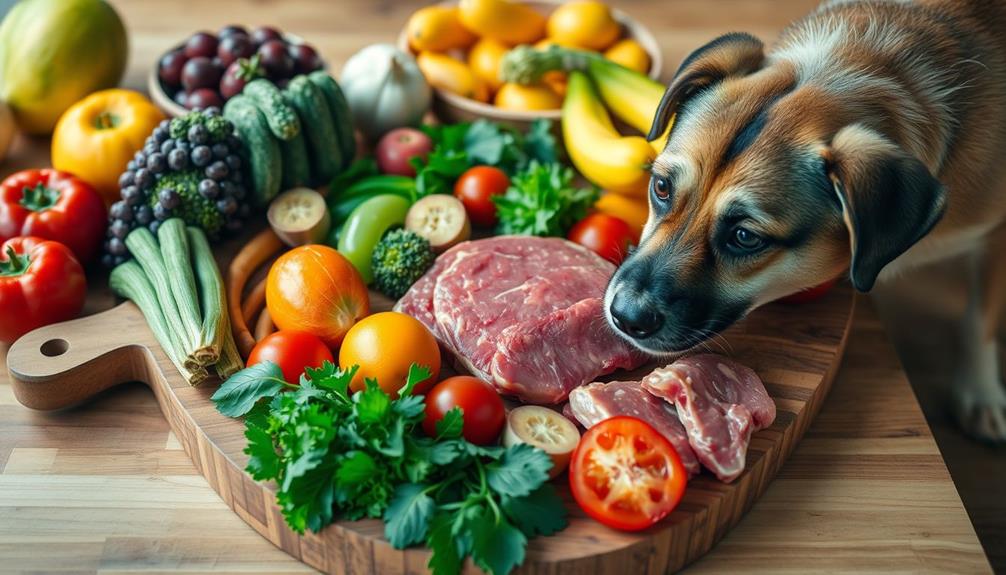
When considering your dog's diet, fresh food options present a compelling alternative to traditional kibble. Fresh food typically includes natural ingredients like beef, chicken, peas, and blueberries, which can improve your dog's heart health, energy levels, and coat condition.
Unlike kibble, which often contains preservatives and fillers, fresh food diets are formulated to meet AAFCO standards, guaranteeing they're complete and balanced for your pet's nutritional needs.
Many subscription services offer customizable meal plans, allowing you to select recipes and portion sizes tailored to your dog's specific requirements. This flexibility can make feeding raw or fresh food easier.
If you prefer to prepare homemade fresh food, you'll need to invest time and money. Consulting with veterinary nutritionists is essential to confirm your meals are properly formulated.
Additionally, fresh food services typically provide guidance on food storage and freshness maintenance, so your dog receives ideal nutrition from every meal.
Frequently Asked Questions
Do Vets Recommend Kibble or Fresh Food?
When you ask vets about kibble or fresh food, many recommend considering your dog's specific needs. Some advocate fresh diets for better health, while others find kibble convenient and nutritionally adequate for many dogs.
What Is the Healthiest Food to Feed Your Dog?
When considering the healthiest food for your dog, focus on options rich in protein and low in carbohydrates. Prioritize fresh, whole ingredients that support hydration, energy levels, and overall health for your furry friend.
What Is Better for Dogs, Kibble or Fresh Food?
When it comes to your dog's diet, think of it as choosing between a vibrant garden and a dusty shelf. Fresh food often offers better hydration, nutrition, and health benefits compared to traditional kibble, enhancing your pup's energy.
What Is the #1 Best Dog Food?
The #1 best dog food is one that meets AAFCO standards, tailored to your dog's needs. Consider high-quality ingredients, balanced nutrition, and consult your vet for personalized recommendations to guarantee peak health for your furry friend.
Conclusion
Choosing between raw food and kibble for your dog is like picking a path in a dense forest; both have their benefits and potential pitfalls. Raw diets can offer fresher, nutrient-rich options, while kibble provides convenience and stability. Ultimately, it depends on your dog's needs, your lifestyle, and how comfortable you are with food handling. Whichever route you take, guarantee it's balanced and healthy for your furry friend—after all, their health is worth every step you take. If you decide to go the raw food for dogs route, be sure to thoroughly research and consult with your veterinarian to ensure that your dog is getting all the necessary nutrients. It may require more time and effort to prepare and handle raw food, but the potential health benefits for your dog can be well worth it. Remember, a balanced and healthy diet is key to a happy and thriving canine companion.

